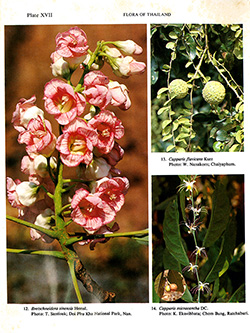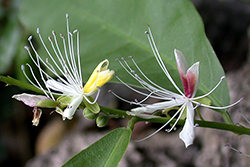e-Flora of Thailand
Volume 5 > Part 3 > Year 1991 > Page 246 > Capparaceae > Capparis
5. Capparis micracantha DC.wfo-0000584901
Prod. 1: 247. 1824; Hook.f. & Thomson in Fl. Br. Ind. 1: 179. 1872; Kurz, Fl. Burm. 1: 61. 1877; Gagnep. in Fl. Gén. I.-C. 1: 186. 1908; Craib in Fl. Siam. En. 1: 82. 1925; Jacobs in Fl. Mala. I. 6: 85. 1960; Back. & Bakh.f., Fl. Java 1: 185. 1963; Jacobs, Blumea 12: 466. 1965.
Accepted Name : This is currently accepted.
Synonyms & Citations :
Description : Shrub or small tree, 1–6 m high; branches glabrous, mostly zigzag; shootwith cataphylls at base; thorns directed upwards, 2 mm long. Leaves oblong, elliptic, ovate or sometimes rounded, 8–24 by 4–10.5 cm, papery; base obtuse to rounded or subcordate; apex obtuse, rounded, acute or slightly emarginate, with a callose mucro; coriaceous, glabrous, shining; nerves 5–10 pairs. Petiole 1–1.5 cm. Flowers arranged in supra-axillary rows, up to 7 flowers in each axil. Pedicels 1 cm, pubescent. Sepals ovate or oblong, 4–10 by 2–4 mm, subcori-aceous, ciliate. Petals oblong, 10–15 by 3–7 mm, thin, obtuse to rounded; distinctly veined, tomentose on both sides. Stamens ca 30. Gynophore 1.5–3 cm long. Ovary ovoid or ellipsoidal, 3 by 1–1.5 mm, glabrous. Fruits ellipsoid, globose or elongated, 1.5–7 by 1.5–3.5 cm; pericarp woody, coriaceous when dry; stipe 3.5–4 cm long, 3–6 mm thick. Seeds numerous, reniform, 7 by 5–6 mm.
Thailand : NORTHERN: Lampang (Mae Yom), Phrae, Sukhothai, Phitsanulok (Thung Salaeng Luang, Nakhon Thai), Kamphaeng Phet, Nakhon Sawan (Phayuha Khiri); NORTH-EASTERN: Khon Kaen (Phu Wiang), Phetchabun, Sakon Nakhon; EASTERN: Buri Ram, Nakhon Ratchasima (Pak Thong Chai, Khao Yai), Surin; CENTRAL: Krung Thep Maha Nakhon (Bangkok), Chai Nat, Nakhon Nayok (Sarika Falls), Saraburi (Sam Lan, Phu Khae); SOUTH-EASTERN: Chachoengsao (Khao Hin Son), Chanthaburi (Khao Soi Dao), Chon Buri (Si Racha, Khao Khieo, Laem Chabang), Prachin Buri, Rayong (Ban Phe); SOUTH-WESTERN: Uthai Thani (Ban Rai), Kanchanaburi (Sai Yok), Prachuap Khiri Khan (Sam Roi Yot, Hua Hin, Kui Buri), Ratchaburi; PENINSULAR: Chumphon, Surat Thani (Khao Sok, Khirirat Nikhom), Nakhon Si Thammarat, Songkhla, Narathiwat, Pattani, Satun (Tarutao), Yala.
Distribution : India, Burma, Indochina, China, Hainan, Andaman Islands, Malesia (Java – type), the Philippines (Celebes and Moluccas).
Ecology : Common in evergreen forests, mixed deciduous forests, dry limestone hills, dry dipterocarp forests, open roadside thickets and limestbne ridges near the sea, 100–500 m alt. Flowering: August–April; fruiting: May–November.
Vernacular : Sae ma thalai (แซ้ม้าทะลาย), nuat maeo daeng (หนวดแมวแดง)(Northern); kradat khao (กระดาษขาว), krarok yai (กระโรกใหญ่), ching-cho (จิงโจ้), chingchi (ชิงชี่), phaya chom pluak (พญาจอมปลวก), khon khong (ค้อนก้อง)(Central); chai chu (ชายชู้), mak mok (หมากหมก)(Eastern); kradat pa (กระดาษป่า), siso (ซิซอ)(Southeastern); phuang marado (พวงมาระดอ), mengso (เม็งซอ), ram (ราม)(Peninsular).


